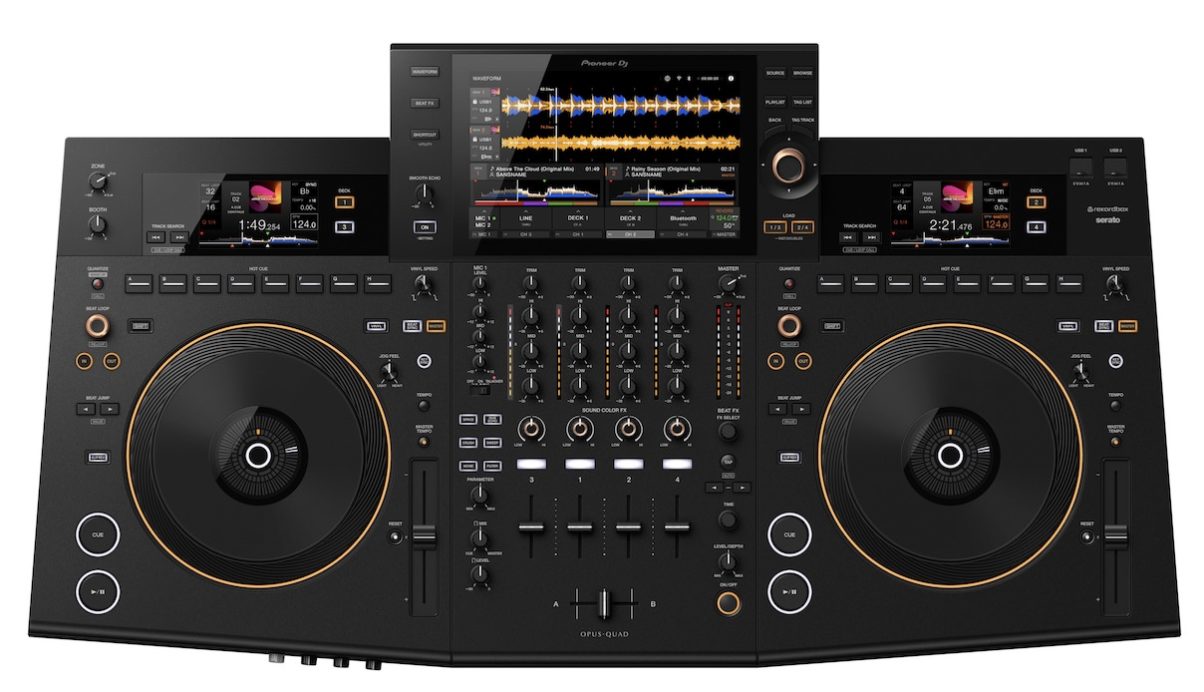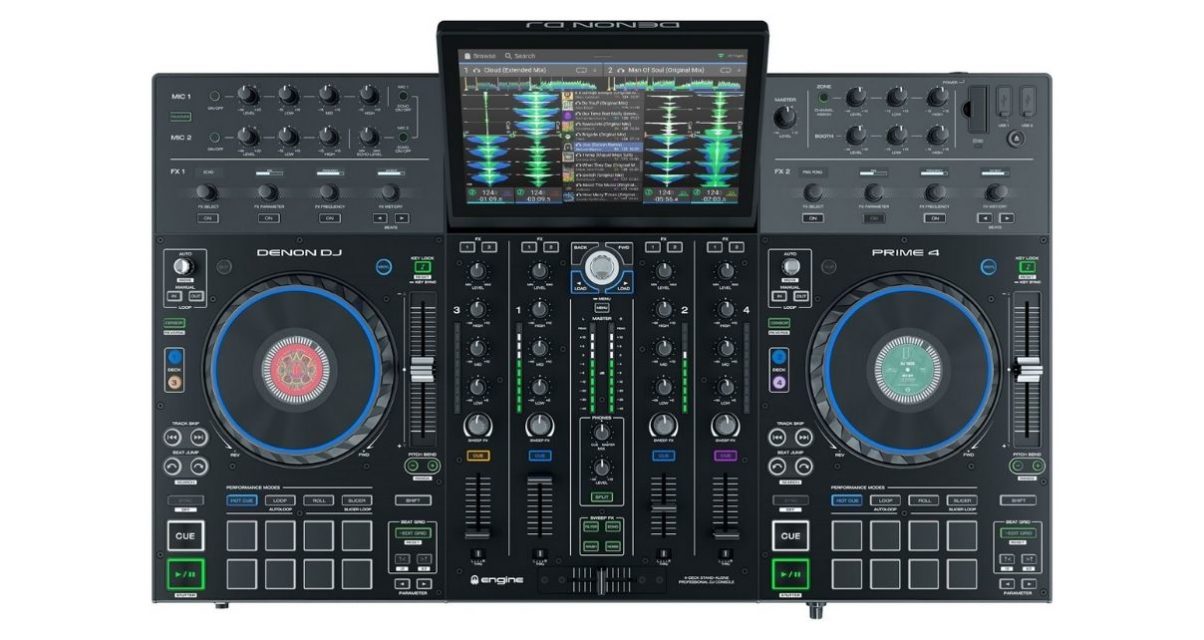So with the Opus Quad (here’s our Pioneer DJ Opus Quad review), Pioneer DJ has finally launched an all-in-one, standalone DJ system that can compete with the Engine DJ-powered Denon DJ Prime 4 (here’s our Denon DJ Prime 4 review).
Watch the show
Prefer to watch this? We compared the Opus Quad and Prime 4 side by side in this free live lesson, and also took questions from our DJ community on the subject.
The Prime 4 redefined what standalone DJ gear can do. True four-channel laptop-free DJing, onboard WiFi for streaming services, on-board track analysis, on-board sync and beatgridding, a big touchscreen, zone output for playing completely different music in a second room – it was (and is) a great unit.
But guess what? The Opus Quad can do all of the above. And, it’s different enough from the Prime 4 to give DJs looking for an “ultimate” all-in-one solution a decision to make. So in this article, we’ll look at 13 key differences between the two units, to help you decide which may be right for you.
Want help choosing gear? Grab your free PDF: The Digital DJ Gear Buyer’s Guide

Opus Quad Vs Prime 4 – Key Differences
- They feel fundamentally different – The Opus Quad is bigger, angled, has curves, and is more spacious in use. The Prime 4 is flatter, has an adjustable screen, and is altogether more crowded, control-wise. DJ gear has to feel right to the user – I suspect that reading/watching this you’ll have a definite, instinctive preference, and you should follow that
- The Opus Quad has CDJ jogwheels, the Prime 4 has smaller, controller-style jogs – CDJ jogwheels are more “mechanical” in feel, whereas controller jogwheels feel very different, and again, you’ll have a preference
- The Prime 4 has performance pads under the jogs, the Opus Quad has hot cue buttons above them – This (surprisingly to me) is dividing people, some preferring the pads, but others happy with the CDJ-style hot cues, and yet again this will simply come down to preference
- The Prime 4 has an SD slot and on-board hard drive option, the Opus Quad doesn’t – There’s a SATA hard drive bay in the Prime 4, and you can use an SD card with it too rather than a USB drive, if you wish – however, the Quad does have a newer USB-C for your computer
- The Opus Quad has more screen space – Overall they display more info than the Prime 4’s, which has small in-jog screens for artwork only, where the Opus Quad has bigger deck screens above the jogs, meaning the in-jog displays on the Opus Quad can be used just for position info
- The Prime 4 has a drop sample player and DMX/home lighting control… – Both of these things were added after launch as software upgrades, and neither are present on the Opus Quad at launch
- …but the Opus Quad has X/Y effects control, Smooth Echo and Smart Cueing – X/Y is a great feature, combining your choice of effect with a filter. While this isn’t currently on the Prime 4, we are hearing rumblings that it might be coming soon. Likewise, Smooth Echo and Smart Cue are, well, smart performance features both of which we love (they’re demoed in our Opus Quad review)
- Opus Quad has more DJ controller options – You can use it as a DJ controller for Rekordbox DJ (performance mode) and for Serato, whereas the Prime 4 is Serato only (that said, the Prime 4 also works with VirtualDJ, but we expect the Opus Quad will imminently, too)
- Opus Quad has Bluetooth – You can link a Bluetooth source to either channel 3 or 4, which can also be streamed to the zone if you wish, something you can’t do on the Prime 4… up to now (wouldn’t put it past them to add it though)
- The Prime 4 has loop roll, the Opus one doesn’t – Loop roll is a great-sounding performance feature. It could be an easy addition to the Opus Quad, if they would just implement a Slip function, but as of now, there’s no way of doing this
- The Opus Quad has Playlist Banks – This is a cool feature that lets you “bank” together playlists, so you could have up to four sets (for instance, divided by venue) with a different collection of playlists in each
- The Opus Quad is brand-new, the Prime 4 is several years old – If you are one of those DJs who fears buying something only for a new or improved model to drop right afterwards, there’s no chance of that just yet with the Opus Quad, but the Prime Four does feel ready for a refresh as of now
- The Opus Quad is considerably more expensive than the Prime 4 – At least a grand more, which is a large chunk of money. Would you be prepared to pay three grand for an all-in-one DJ system?!

Further Thoughts
Your decision as to which of these to go for (assuming these two are on your shortlist, of course) is likely to come down to two things, should you not already have made up your mind from the above points.
Firstly, how much do you want “Pioneer”? Or how much do you NOT want Pioneer? As the industry leader, it’s a brand that polarises. If you’re a club DJ, you already use Rekordbox, so it may make most sense. But if you love what Denon does, and like a plucky outsider, you may feel more comfortable going with that brand.
Second, though, is a potential big difference that nobody can actually see right now. How confident are you in Pioneer DJ’s commitment to developing the Opus Quad’s platform? When Denon DJ launched the Prime 4, one of our biggest questions was about the parent company’s commitment to developing the Engine DJ platform that powers the Prime 4 (and subsequent related devices).
It turns out that they have developed the platform hugely, and appear to be continuing to put resources into it to make it better and better. How much do you trust Pioneer DJ to do the same with the Opus Quad (and, presumably, other related devices that are coming, too)? Ironically maybe (for laptop free devices) this is becoming a software game. How good a software company is Pioneer DJ going to turn out to be? That’s currently an unknown, and only time will tell.
DJ like a pro using ANY gear: The Complete DJ Course
Whatever you decide, we hope this article has helped, and we’re happy to answer any further questions you may have in the comments below.



